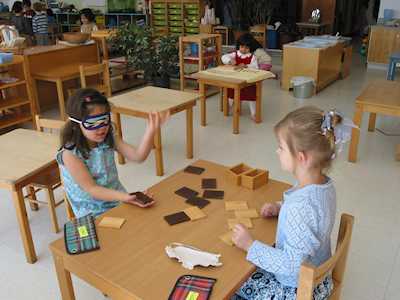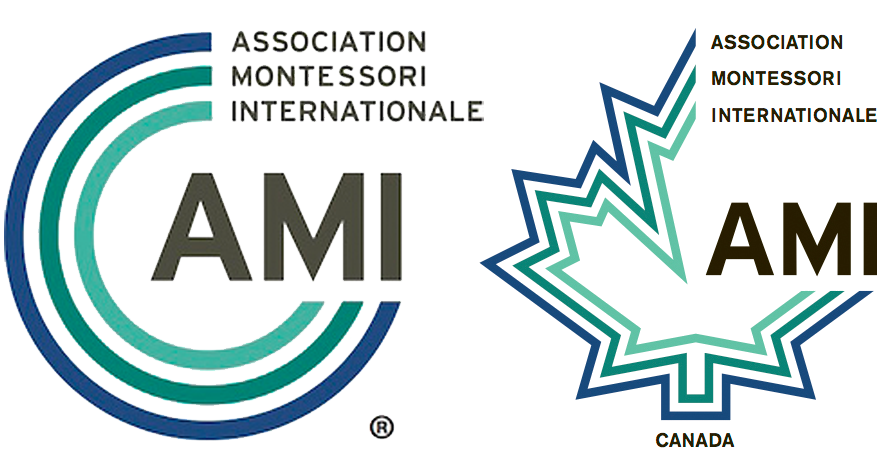Overview of Programs
 Montessori classrooms are multi-aged learning environments, based on the stages of development observed by Dr. Montessori. In the first phase from birth to age six, the child is characterized by the "absorbent mind", absorbing all aspects of the environment, language and culture. In the second phase from age six to twelve, the child uses a "reasoning mind" to explore the world with abstract thought and imagination. In the third phase from twelve to eighteen, the adolescent has a "humanistic mind" eager to understand humanity and the contribution he or she can make to society. In the last phase of development, from age eighteen to twenty-four, the adult explores the world with a "specialist mind" taking his or her place in the world. Maria Montessori believed that if education followed the natural development of the child, then society would gradually move to a higher level of co-operation, peace and harmony.
Montessori classrooms are multi-aged learning environments, based on the stages of development observed by Dr. Montessori. In the first phase from birth to age six, the child is characterized by the "absorbent mind", absorbing all aspects of the environment, language and culture. In the second phase from age six to twelve, the child uses a "reasoning mind" to explore the world with abstract thought and imagination. In the third phase from twelve to eighteen, the adolescent has a "humanistic mind" eager to understand humanity and the contribution he or she can make to society. In the last phase of development, from age eighteen to twenty-four, the adult explores the world with a "specialist mind" taking his or her place in the world. Maria Montessori believed that if education followed the natural development of the child, then society would gradually move to a higher level of co-operation, peace and harmony.
Birth to Three Years
 In the first years of life, the child is developing intelligence, language and movement. The child absorbs from the culture and environment in which he is born and builds his faculties and his personality. There are several Montessori programs for this time from birth to three years.
In the first years of life, the child is developing intelligence, language and movement. The child absorbs from the culture and environment in which he is born and builds his faculties and his personality. There are several Montessori programs for this time from birth to three years.
Nido (‘nest’)
The Nido is the first environment for infants from 8 weeks to 16 months or walking.
Infant Community (Young Children’s Community)
Children may enter the Infant Community when they are walking independently with confidence. The Infant Community is a social community of children designed to support the development of movement, language and independence and where the individual personality is respected. Rather than a classroom, it is a nurturing environment where very young children experience their first structured contact with other children.
Parent-Infant Class
The Parent-Infant Class provides a setting where parents and children, ages 2 – 16 months, interact under the guidance of a trained adult. Parents are guided in their observation of their child and in understanding their child’s development. The environment is equipped with activities for the child, or for both the child and the parent to interact with.
Three to Six Years
The Children’s House or Casa dei Bambini is an environment designed for the young child. The combination of beauty and order attracts the child to explore. The child chooses activities, working purposefully and independently. The freedom to choose his own activity and to repeat as long as he likes encourages self-directed activity and deep concentration. The activities meet the child’s interests and developmental needs fostering spontaneous, self-directed choices.
There are four main areas in the Casa program: Practical Life, Sensorial, Language and Mathematics. Considerable emphasis is also placed on cultural aspects such as music, art, geography, botany and zoology.
Practical Life: The activities of Practical Life instill care of the self, care of others and care for the environment. Many of these activities are ones the child sees done at home, such as sweeping, washing, ironing, arranging flowers, etc. Grace and courtesy supports the child’s social development. Children develop fine and gross motor coordination and control. They learn to work at a task from beginning to end and to assume responsibility for themselves and for their classroom environment.
Sensorial: From an early age, children seek to sort, order and classify their experiences and impressions of the world. The Sensorial materials attract the child to explore these physical qualities of the world through his sense of touch, hearing, sight, taste and smell. Through this exploration, the child refines perception and forms a basis for abstract thought. Precise language is attached to these sensorial experiences to support classification and self-expression.
Language: The Montessori environment provides rich spoken language including conversations, stories, poems, songs and fingerplays. Sandpaper letters help children link the sounds and symbols of our written language, so that they begin to write before they read. As they trace these sandpaper letters they are practising the movements required to write these cursive letters. Earlier activities of Practical Life and Sensorial have prepared the hand and fingers for the act of writing. With the familiarity of the sounds of the letters, children discover that they can read back labels and messages. They are introduced to further keys to support the irregularities of reading English and to explore the function of words and structure of sentences. Children develop fluency and a deep appreciation of what they read.
Mathematics: The child’s mind has been awakened to mathematical notions such as dimension, gradation, identity similarity and sequence through sensorial experience. The concrete materials help the child to develop a solid understanding of mathematical concepts, prepare them for reasoning and help develop problem-solving capabilities. The child learns to add, subtract, multiply and divide and to see the numerical, geometrical and dimensional relationships within the decimal system.
Six to Twelve Years
 The Elementary environment is designed for the reasoning mind and expanding imagination of the six to twelve year old. Children may be grouped in classes of 6 – 9 years, 9 – 12 years or 6 – 12 years.
The Elementary environment is designed for the reasoning mind and expanding imagination of the six to twelve year old. Children may be grouped in classes of 6 – 9 years, 9 – 12 years or 6 – 12 years.
Children work in a research style of learning, in small groups on a variety of projects which spark the imagination, deepen interest and engage the intellect. Lessons given by a trained Montessori teacher direct the children toward activities that help them develop reasoning abilities, problem-solving and social skills as they master the arts of life. The insatiable urge in children at this age to understand the universe and their place within it directs the elementary work toward all aspects of culture. Elementary studies include geography, biology, history, language, mathematics in all its branches, science, music and art. Exploration of each area is encouraged through trips outside the classroom to community resources, such as library, planetarium, botanical garden, science centre, factory, hospital, etc. This inclusive approach to education fosters a feeling of connectedness to all humanity, and encourages children’s natural desire to make contributions to the world.
Twelve to Eighteen Years
The Montessori program for children aged 12 to 18 years is based on the recognition of the special characteristics of adolescence. Adolescence is an age of great social development, an age of critical thinking and re-evaluation, and a period of self-concern and self-assessment. It is a transition from childhood to adulthood with the corresponding physical, mental and sexual maturation. In early puberty the adolescent finds it hard to concentrate on academic and structured learning. Above all adolescence is like an odyssey - an arduous yet exciting adventure - where the adolescent tries to find his or her place in the world.
Erdkinder - Twelve to fifteen Years
Dr. Montessori’s model of education for the adolescent is the Erdkinder (land – children). She recommended that the adolescent should spend a period of time in the country away from the environment of the family. This would provide an opportunity to study civilisation through its origin in agriculture. She suggested they should live in a hostel which they would learn to manage and open a shop where sale of produce would bring in the fundamental mechanics of society, production and exchange on which economic life is based. She outlined a general plan for their studies and work but believed that the program could only be developed from experience under the guidance of adults with various specializations. Some schools in North America are offering an urban Montessori experience for adolescents, in some instances with opportunities for work on the land and for the sale of good and/or services.

